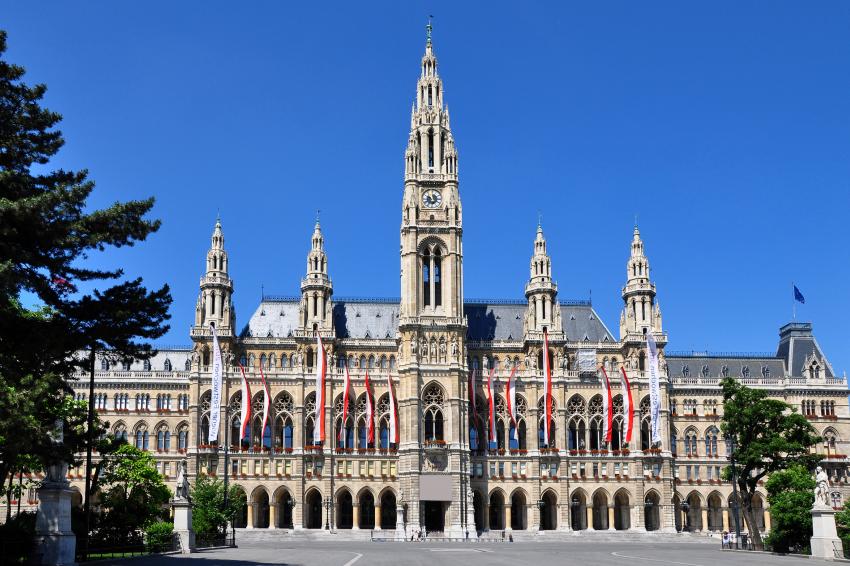Labor Strauss: Fire protection in Historical Buildings
Helping to preserve the Cultural Heritage of Europe
With fire detection systems and automatic extinguishing control systems, Labor Strauss supplies the central elements for the fire protection systems used in historical buildings. The extensive know-how and the constant innovation of the Austrian company help preserve the cultural heritage of Europe.
There are events which stick in the collective memory. The fire of Notre-Dame in April 2019 is definitely one of them. The cathedral in the heart of Paris is not only a symbol of the city, like no other building Notre-Dame embodies the history and identity of all of France. Millions of people all over the world watched speechlessly as Notre-Dame was blazing fiercely and asked themselves how something like that could happen. Now it is clear that the fire broke out in the course of renovation work on the roof. Due to the wood construction, the roof is one of the main weak spots – especially in historical buildings, explains Ing. Herbert Pflügl from the Labor Strauss Group.
For more than 28 years now, the specialist has taken care of various historical buildings for LST and has first-hand knowledge of the specific challenges of fire protection in historical buildings. LST's references include the Vienna City Hall as well as the Natural History Museum Vienna, the Benedictine Monastery Admont in Styria, the Museo del Prado in Madrid and the Parliament in Budapest.
In the case of historical buildings, all persons involved have to be willing to compromise and have to try to bring the requirements of fire protection and of the protection of historical buildings into line. This is no easy task since the installation and operation of an extensive fire detection system also involves high costs.
Every second counts
Experience has shown that most fires in historical buildings are caused by either faults in electrical systems and devices or by arson. This is also the reason why early fire detection is so important. Only then can visitors, buildings and cultural possessions be protected effectively and a total loss be prevented. For this purpose, LST offers different systems, such as beam smoke detectors, highly sensitive laser smoke detectors or smoke aspiration systems, which guarantee optimum early fire detection.
Wide field of application
LST's wireless detectors Series FI720/RF are ideal for places where you must not chisel or install cables - a situation which very often exists in historical buildings. Both optical and thermal wireless detectors are available as well as a combination of both technologies. Wireless optical smoke detectors are based on the principle of scattered light, detect smoke particles, and can be used in a very wide field of application. Wireless thermal detectors are activated as a result of a rapid rise in temperature or when a fixed alarm threshold is exceeded. Here, the maximum temperature at which the wireless detector is activated can be set. For optimum fire detection, LST recommends wireless optical-thermal detectors. The Series FI720/RF wireless detectors have a range of up to 200 metres or – if RF expanders are used – of more than 3 kilometres.
Connected directly to the loop
For monitoring large areas, beam smoke detectors are a good choice, explains the fire protection expert. They operate on the principle of a light barrier. With a pulsed infrared ray or a LED unit, a range of 5 to 100 metres can be covered. If smoke attenuates the intensity of the light beam, the smoke detector raises an alarm. The sensitivity of the detector can be regulated by selecting one of six levels. Through special algorithms, the software can compensate for the contamination of the optical system, which considerably helps avoid deceptive alarms. The Beam Smoke Detector 6500 is connected directly to the loop of the fire detection control panel and does not require an external power supply.
Active systems monitor the concentration of smoke
A further technical variant of early fire detection are smoke aspiration systems by means of which one or two independent fire areas can be monitored. What makes LST's smoke aspiration systems stand out is their high response sensitivity. Through a pipe network, air is sampled from the room that is to be monitored, and is analysed by a special detector. If the concentration of smoke exceeds the permissible value, an alarm is transmitted to the fire detection control panel. Here, a smoke aspiration system ensures continuous monitoring of the whole area of large rooms, up to high roof trusses such as those found above naves.
Structural measures in historical buildings
In addition to early fire detection, some architectural precautions can be taken which are compatible with the protection of historical buildings and which delay the spread of a fire, explains Pflügl. With appropriate fire doors and construction methods that consider fire protection, fire areas can be created by means of which individual areas can be separated, which, in turn, can prevent the fire from spreading quickly. Furthermore, smoke extractor and forced ventilation systems are also important fire protection elements and, among other things, help keep escape routes free.
Interfaces to extinguishing systems
All information from the fire detectors is collected by the fire detection control panel, which then activates an alarm and notifies the fire prevention officer, the fire brigade and the security service. LST offers an extensive portfolio of fire detection control panels by means of which all possible applications can be covered and which can expand with ease as the requirements grow. Furthermore, different extinguishing systems can also be actuated through the fire detection control panel. As a result, the fire fighting can be initiated even before the fire brigade arrives. In historical buildings and museums, special extinguishing agents such as chemical extinguishing gases are used so as not to affect the structural fabric or the works of art.
Beyond the pure fire prevention system
However, LST not only sees itself as supplier of systems, but also plays an active part in planning and coordinating complex projects in which various devices have to be connected.
„One of our strong points is our approach that also considers other devices. In the planning and execution phase, we take on the overall control of the entire fire detection and fire control system until the acceptance by a certified inspection authority", stresses Pflügl. "Periodically maintaining the systems according to the standards is another important factor for the reliable operation and is also carried out by us."
Contact
Labor Strauss Sicherungsanlagenbau GmbH
Wiegelestraße 36
1230 Wien
Austria
+43 /1/52114-0
+43/1/52114-27












